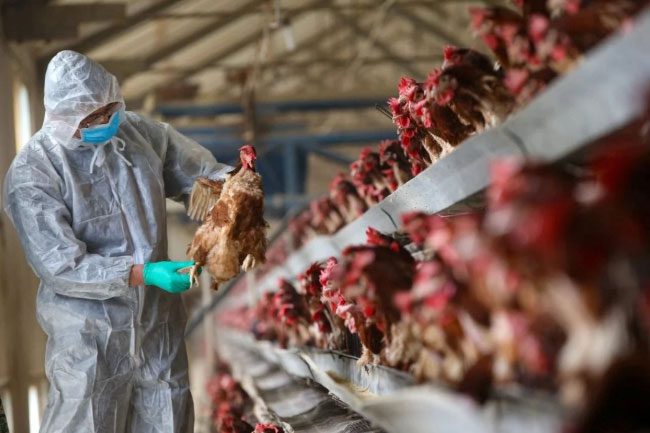Research in China has provided new evidence suggesting that the world may be on the brink of another pandemic as cases of avian influenza emerge in certain regions affecting poultry, livestock, and humans.
Type A avian influenza virus is classified into subtypes based on the combination of two types of proteins on their surface – hemagglutinin and neuraminidase – referred to as HxNy.
According to the Centers for Disease Control and Prevention (CDC) in the United States, only two subtypes of avian influenza A – H1N1 and H3N2 – are known to circulate among humans.
A study led by a top Chinese virologist has raised concerns that a new H2N2 virus strain found in nature may now be capable of infecting humans, increasing the need for closer surveillance.
Various strains of the virus have been found in bird species and other animal populations worldwide, some of which could potentially infect humans.
George Fu Gao, an immunologist who served as the director of the Chinese Center for Disease Control and Prevention from 2017 to 2022, published a paper with his team at the Chinese Academy of Sciences investigating the specific H2N2 virus strain.
Decades ago, another H2N2 strain caused the “Asian flu” pandemic, which broke out in 1957 in southern China and quickly spread globally, claiming over 1 million lives, according to the CDC.
After the pandemic, H2N2 became a seasonal flu strain and eventually disappeared from the human population by the late 1960s, although low-virulence strains continue to circulate in Chinese poultry.
In a paper published in the peer-reviewed journal Nature Communications on November 19, Gao and his research team reported that after examining several H2N2 strains, a strain from 2021 could bind to both avian and human receptors on the surface of host cells.
While this H2N2 strain still prefers avian receptors, the authors noted that the virus responsible for the original Asian flu also initially favored dual receptors but adapted over time to human receptors.
The research team’s experiments on mice, guinea pigs, and ferrets indicated that the H2N2 strain could rapidly adapt to mice and acquire mutations that facilitate its transmission to guinea pigs and ferrets, which are preferred animal models for flu.
The researchers also examined the impact of individual mutations on the transmissibility and virulence of the 2021 H2N2 strain and found that some mutations could change the binding preference to human receptors.
Despite the similarities between the recent H2N2 strain and the pandemic strain from 1957, the research team stated that genetic differences and the time elapsed since the Asian flu emerged render the world susceptible to a future outbreak.

There are similarities between the recent H2N2 strain and the strain that caused the pandemic in 1957.
The research team noted that the pathogenic risk of H2N2 remains low, with limited transmission among mammalian species, thus reducing the overall risk of a pandemic from circulating H2N2 strains.
“However, the low-pathogenic H2N2 avian influenza strain has just acquired limited mutations that increase virulence in mice and allow transmission between mammalian species,” the research team stated.
One of the most well-known variants of avian influenza A is H1N1 – also known as swine flu – which caused the first pandemic of the 21st century in 2009.
According to the CDC, a common avian influenza strain – H5N1 – has become a focal point due to outbreaks on dairy farms in the United States, leading to over 40 reported human infections in the U.S. this year.
Most cases were associated with direct contact with cattle or poultry, and no recent cases were due to human-to-human transmission, but experts indicate that this possibility still exists.
Among more than 900 confirmed H5N1 cases reported to the World Health Organization from 2003 to 2024, about half resulted in fatalities.
Outbreaks in livestock are particularly concerning as the virus can undergo recombination or exchange genomic segments between different viruses. When avian influenza viruses infect pigs – which can harbor both human and avian diseases – the risk of reassortment with seasonal human influenza increases.
Another paper published in the journal Nature Microbiology on Monday by a group of researchers from the United States and the Netherlands indicated that H5N1 could pose a much greater pandemic risk.
In a brief communication, the scientists stated that they began researching H5N1 due to the “sudden changes” recently observed in this virus, characterized by ongoing outbreaks in dairy livestock in the United States.
The researchers examined the viral shedding process – the expulsion of viral particles through processes such as exhalation – of new H5N1 strains compared to older strains in ferrets.
The research team found that compared to H5N1 viruses from the 2000s, recent viruses exhibit “low but increasing” airborne viral shedding, which may explain the recent rise in transmission among livestock.
The Chinese research team stated: “Enhanced surveillance of [avian influenza] viruses in animals and assessing community health risks from [avian influenza] viruses are essential to control and prevent emerging and re-emerging pandemic influenza.”


















































